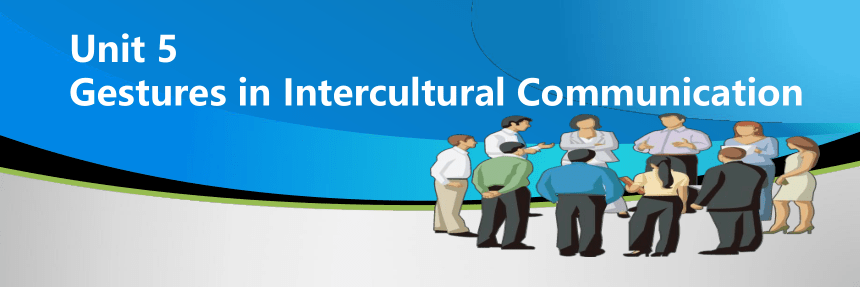(
课件网) Unit 5 Gestures in Intercultural Communication Gestures are non-vocal bodily movements intended to express meanings. Gestures can be emblems or symbols (“V” for victory), illustrators (police officer’s hand held up to stop traffic), regulators (glancing at your watch to signal that you are in a hurry), or affect displays (one’s face turns red with embarrassment). They may be presented with the hands, arms or body, and also include movements of the head, face and eyes, such as winking, nodding, or rolling one’s eyes. We use gestures daily, almost instinctively, from beckoning to a waiter, or punctuating a business presentation with visual signals, to airport ground attendants guiding an airline pilot into the jet way. In a very general sense, we all use gestures to reinforce an idea or to help describe something. When we say “That’s an English book”, at the same time we are pointing to the book. If someone asks us the way to the library, we point to the right, adding a little more clear and concrete information about it. People in Angola have to wink their eyes to welcome distinguished guests, which is quite different from other countries. Other examples include the OK-sign. It may be understood as symbolizing the number zero, or being worthless. It may also be seen as symbol of being obscene. A frequently mentioned case is: Nixon, past president of the United States, once paid a visit to Brazil. While he was disembarking the plane, he made a gesture of “OK”, which angered and insulted the Brazilians. The American gesture of “OK” is considered obscene in Brazil. In the end, Nixon formally apologized to the Brazilians. Interpretations of gestures are culture bound. As many movements are carried out at a subconscious or at least low-awareness level, they always carry a significant risk of being misinterpreted in an intercultural communication situation. Unfortunately, the sheer variety and complexity of gesture makes it impossible to find an easy solution. Quaint “Do’s and Don’ts” can never solve the complicated problems alone. For instance, Russian people are said to have extraordinary splendid traditions and customs, and bold and unconstrained characters, but their gesture is characterized only by using one hand (usually the right hand), and the other keeping fixed, and moving only slightly when necessary. Now, we shift to the discussion about gesture. The same gestures with different meanings encoded in different cultures are presented in this part for the sake of comparison. The thumbs-up sign: In Britain, the thumb-up gesture means “good, great”. It is also used for hitch-hiking, asking for a free ride. This gesture signals approval in China, the U. S. and Russia as in Britain. But in Persian culture, it is highly offensive. In the U.K., Australia and New Zealand, it has the meaning of sign rider or an insult sign to people, with a sharp bent thumb. In Greece, th ... ...

